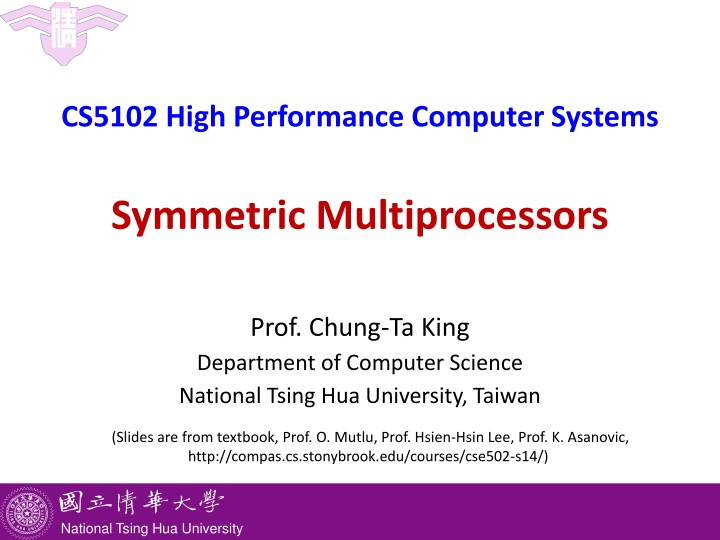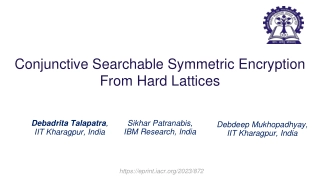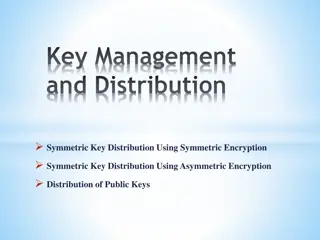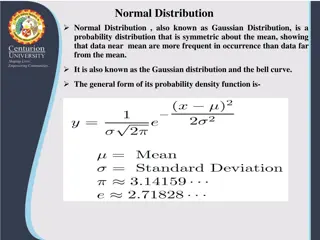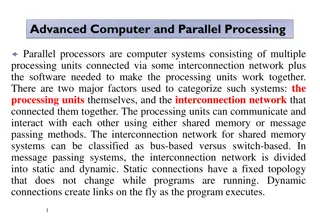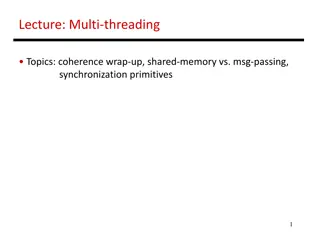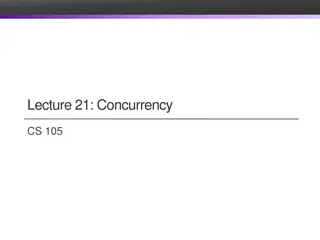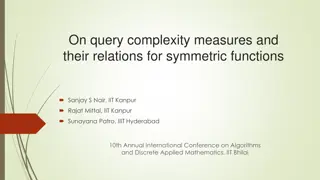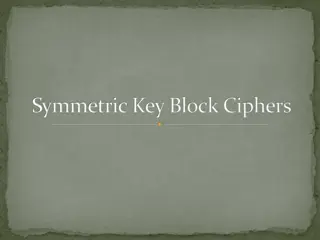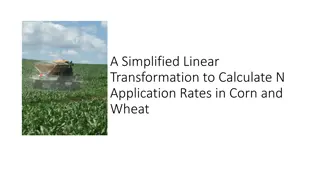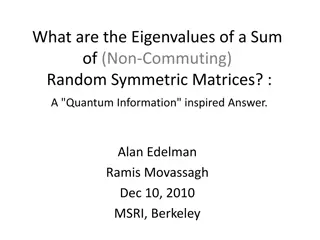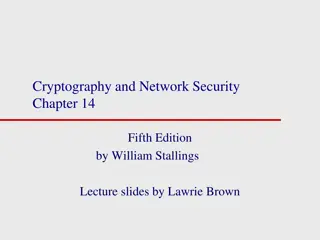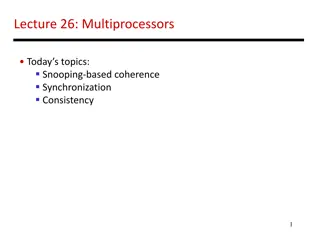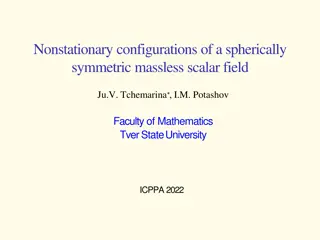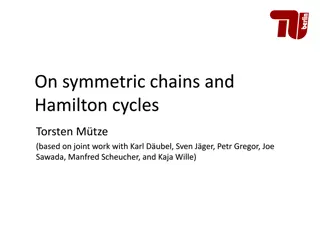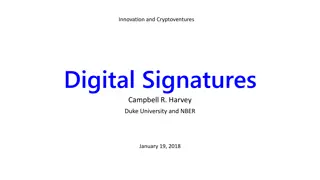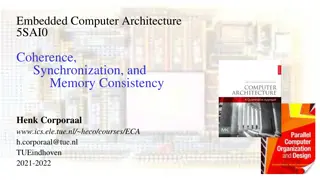Symmetric Multiprocessors
Delve into the world of symmetric multiprocessors with a focus on centralized shared-memory architectures, distributed shared-memory systems, memory consistency models, and synchronization basics. Explore the challenges and solutions of shared memory models in high-performance computer systems.
Download Presentation

Please find below an Image/Link to download the presentation.
The content on the website is provided AS IS for your information and personal use only. It may not be sold, licensed, or shared on other websites without obtaining consent from the author.If you encounter any issues during the download, it is possible that the publisher has removed the file from their server.
You are allowed to download the files provided on this website for personal or commercial use, subject to the condition that they are used lawfully. All files are the property of their respective owners.
The content on the website is provided AS IS for your information and personal use only. It may not be sold, licensed, or shared on other websites without obtaining consent from the author.
E N D
Presentation Transcript
CS5102 High Performance Computer Systems Symmetric Multiprocessors Prof. Chung-Ta King Department of Computer Science National Tsing Hua University, Taiwan (Slides are from textbook, Prof. O. Mutlu, Prof. Hsien-Hsin Lee, Prof. K. Asanovic, http://compas.cs.stonybrook.edu/courses/cse502-s14/) National Tsing Hua University
Outline Introduction (Sec. 5.1) Centralized shared-memory architectures (Sec. 5.2) Distributed shared-memory and directory-based coherence (Sec. 5.4) Synchronization: the basics (Sec. 5.5) Models of memory consistency (Sec. 5.6) 1 National Tsing Hua University
Centralized Shared-Memory Architecture Key insight: large multilevel caches can substantially reduce memory bandwidth demands of a processor allow multiple processors to share memory Support caching of shared and private data Private data: used by a single processor Shared data: used by multiple processors provide (indirect) communication among processors through reads and writes of shared data 2 National Tsing Hua University
Shared Memory Model Many parallel programs communicate through shared memory P0 writes to an address, followed by P1 reading This implies communication between the two Proc 0 Mem[A] = 1 Proc 1 Print Mem[A] Each read should receive the value last written not only by itself but also by anyone need synch. What does last written mean? What if Mem[A] is cached (at either end)? 3 National Tsing Hua University
Shared Memory Model SMP needs to provide the illusion of a single shared memory But, actually, it has multiple private caches for performance reasons Closer cache level can be private, and multiple copies of a cache block can be present in the private local cache across different processors Basic question: If multiple processors cache the same block, how do they ensure they all see a consistent state (value)? Local updates lead to incoherent state Problem in both write-through and writeback caches 4 National Tsing Hua University
Example: Write-Back Cache P0 P1 Pn LD? LD? Cache Cache Cache X= -100 X= -100 X= -100 X= 505 X= -100 Memory 5 National Tsing Hua University
Example: Write-Through Cache P0 P1 Pn LD? Cache Cache Cache X= -100 X= 505 X= -100 X= 505 X= -100 X= 505 Memory 6 National Tsing Hua University
Maintaining Coherence Need to guarantee that all processors see a consistent value (i.e., consistent updates) for the same memory location Informally: Any read must return the most recent write (Too strict and very difficult to implement) Better: Any write must eventually be seen by a read If P0 writes x and P1 reads it, P0 s write will be seen if the read and write are sufficiently far apart All writes are seen in same order ( serialization ) e.g., w1 followed by w2 seen by a read from P1, will be seen in the same order by all reads by other processors 7 National Tsing Hua University
Hardware Cache Coherence System ensures everyone always sees latest value Basic strategy: let a write be known by all A processor/cache broadcasts its write/update to a memory location to all other processors/caches Another cache that has a local copy of the memory location either updates or invalidates its local copy Serialization: only one can broadcast at a time How can we safely update replicated data? Option 1 (update protocol): push the update to all copies Option 2 (invalidate protocol): invalidate all others to ensure there is only one valid copy (local), and update it On a read: If local copy isn t valid, request it either from the memory or from the node holding the valid copy 8 National Tsing Hua University
Two Cache Coherence Methods How to broadcast the update? Snoopy bus: (you shout at everyone) Bus-based, single point of serialization for all requests Processor broadcasts updates on bus totally ordered Processors observe ( snoop ) other processors actions Directory: (you tell someone to inform all others) Directory tracks ownership (sharer set) for each block Processors explicitly request for blocks through directory Directory coordinates invalidation/update appropriately Serves as ordering point for conflicting requests in unordered networks No single broadcast media more complex but scalable 9 National Tsing Hua University
Snoopy Cache Coherence All caches snoop all other caches read/write requests and keep the cache block coherent Cache controller updates cache block states in response to processor & snoop events and generates bus transactions Snoopy cache tags are dual-ported Used to drive memory bus when cache is bus master A A Snoopy read port attached to memory bus Tags and State R/W Proc. R/W Data (blocks) D Cache 10 National Tsing Hua University
Snoopy Cache Coherence Easy to implement if all caches share a common bus Each cache broadcasts its read/write operations on bus Simple finite state machine (FSM) for each cache block Good for small-scale multiprocessors Memory Bus Main Memory (DRAM) Snoopy Cache CPU1 Snoopy Cache DMA Disk CPU2 Snoopy Cache CPU3 Network DMA 11 National Tsing Hua University
Bus Snooping for Write-Through Cache Allows multiple readers, but writes always through to memory via bus All the writes will be seen as a transaction on the shared bus to memory Two protocols Update-based protocol Invalidation-based protocol P P P $ $ $ Bus-based shared memory Memory 12 National Tsing Hua University
Bus Snooping (Update-based Protocol on Write-Through Cache) P1 P2 Pn Cache X= -100 X= 505 Cache Cache X= 505 Bus transaction Memory X= -100 X= 505 Bus snoop Update local copies upon snoop hit 13 National Tsing Hua University
Bus Snooping (Invalidation-based Protocol on Write-Through Cache) P1 P2 Pn Load X Cache X= -100 X= 505 Cache Cache X= 505 Bus transaction Memory X= -100 X= 505 Bus snoop Invalidate local copies upon snoop hit (but the updated data has already been broadcasted on bus!) 14 National Tsing Hua University
Effects of Bus Snooping When a processor writes to its local copy, this fact is broadcasted to all other caches and all caches will see the same update write propagation When two processors write to their individual local copy of the same data at almost the same time, one processor will win the bus and broadcast its update information to all other caches. The other update must wait until it can grab the bus. This guarantees that all other caches see the same order write serialization 15 National Tsing Hua University
Update vs. Invalidate Tradeoffs Update + If sharer set is constant and updates are infrequent, avoid the cost of invalidate-reacquire (broadcast update pattern) - If data is rewritten without intervening reads by other processors, updates are useless - Write-through cache policy bus becomes bottleneck Invalidate + After invalidation broadcast, processor has exclusive rights + Only processors that keep reading after a write keep copy - Longer delay in reacquire the invalidated block - If write contention is high, leads to ping-ponging (rapid mutual invalidation-reacquire) 16 National Tsing Hua University
A Simple Snooping Coherence Protocol For a write-through, invalidation-based, no write- allocate cache Processor requests Load, Store Bus messages BusRd, BusWr 1 bit state per cache block Valid/Invalid Store/BusWr Load/-- Valid Load/BusRd BusWr/-- Invalid Observed / Bus transaction Processor-initiated transaction Bus-snooper-initiated transaction Store/BusWr 17 National Tsing Hua University
How about Write-Back Caches? Write-back caches only write to local caches until the block is to be replaced Cache and memory may be incoherent Reduce bus write bandwidth no bus activities on writes What problems the valid-invalid protocol may have? Solution 1: force every store to go to bus Solution 2: ensure exclusive right to write No other cache, nor memory, has a valid copy except local can write to local copy many times without letting others know Need to further differentiate Valid state: (1) exclusive and dirty, (2) shared and clean 18 National Tsing Hua University
How about Write-Back Caches? Divide Valid state into exclusive-dirty (Modified) and shared-clean (Shared) Modified: a cache block is in Modified state if it is the only valid and dirty copy in the SMP No other caches, nor memory, has a valid copy A cache owns its Modified blocks and can update them freely When another cache wants to read a Modified block, the block is updated to memory and supplied to that cache; its state now becomes Shared Shared: a cache block is in Shared state if it is clean memory and perhaps other caches have up-to-date copies 19 National Tsing Hua University
Cache Coherence Protocol (Update-based Protocol on Write-back Cache) P1 P2 Pn Store X Cache Cache Cache X= -100 X= 505 X= -100 X= 505 X= -100 X= 505 update update Bus transaction Memory Update data for all processors who share the same data Do not make sense for write-back caches do not consider! 20 National Tsing Hua University
Cache Coherence Protocol (MSI) (Invalidation-based Protocol on Write-back Cache) P1 P2 Pn Store X Cache Cache Cache X= -100 X= -100 X= -100 X= 505 invalidate invalidate Bus transaction Memory Invalidate the data copies for the sharing processor nodes Reduced traffic when a processor node keeps updating the same memory location 21 National Tsing Hua University
Cache Coherence Protocol (MSI) (Invalidation-based Protocol on Write-back Cache) P1 P2 Pn Load X Cache Cache Cache X= 505 X= 505 Miss ! Snoop hit Bus transaction Memory Bus snoop Invalidate the data copies for the sharing processor nodes Reduced traffic when a processor node keeps updating the same memory location 22 National Tsing Hua University
Cache Coherence Protocol (MSI) (Invalidation-based Protocol on Write-back Cache) Store X Store X Store X P1 P2 Pn Cache Cache Cache X= 505 X= 333 X= 987 X= 444 X= 505 Bus transaction Memory Bus snoop Invalidate the data copies for the sharing processor nodes Reduced traffic when a processor node keeps updating the same memory location 23 National Tsing Hua University
MSI Writeback Invalidation Protocol Load, Store/-- Store/ BusWr Load/-- Load/-- Store/ BusRdX Modified Valid Shared BusRd/BusWB BusWr/-- Load/ BusRd Load/ BusRd BusRdX/-- BusRdX/-- Invalid Invalid Store/ BusWr Store/ BusWB 24 National Tsing Hua University
MSI Writeback Invalidation Protocol Track 3 states per cache block Invalid: cache does not have a copy Shared: cache has a read-only, clean copy (memory or other caches are up-to-date) Modified: cache has the only valid copy; the copy is writable for local processor but dirty (memory or other caches are out-of-date) Processor actions Load, Store, Evict (write back) Bus transactions posted by cache controller BusRd, BusRdX, BusWB, 25 National Tsing Hua University
MSI Example P1 P2 P3 Cache Cache Cache X=10 S Bus BusRd Memory X=10 Processor action P1 reads X State in P1 S State in P2 --- State in P3 --- Bus transaction BusRd Data supplier Memory 26 National Tsing Hua University
MSI Example P1 P2 P3 Cache X=10 Cache Cache S X=10 S Bus BusRd Memory X=10 Processor action P1 reads X P3 reads X State in P1 S S State in P2 --- --- State in P3 --- S Bus transaction BusRd BusRd Data supplier Memory Memory 27 National Tsing Hua University
MSI Example P1 P2 P3 Cache X=10 --- Cache Cache S I X=10 X=-25 S M Bus BusRdX Memory X=10 Processor action P1 reads X P3 reads X P3 writes X State in P1 S S I State in P2 --- --- --- State in P3 --- S M Bus transaction BusRd BusRd BusRdX Data supplier Memory Memory --- 28 National Tsing Hua University
MSI Example P1 P2 P3 Cache --- X=-25 Cache Cache I S X=-25 M S Bus BusRd Memory X=10 X=-25 Processor action P1 reads X P3 reads X P3 writes X P1 reads X State in P1 S S I S State in P2 --- --- --- --- State in P3 --- S M S Bus transaction BusRd BusRd BusRdX BusRd Data supplier Memory Memory --- P3 Cache 29 National Tsing Hua University
MSI Example P1 P2 P3 Cache X=-25 Cache Cache S X=-25 S X=-25 M S Bus BusRd Memory X=10 X=-25 Processor action P1 reads X P3 reads X P3 writes X P1 reads X P2 reads X State in P1 S S I S S State in P2 --- --- --- --- S State in P3 --- S M S S Bus transaction BusRd BusRd BusRdX BusRd BusRd Data supplier Memory Memory --- P3 Cache Memory 30 National Tsing Hua University
Summary of the Two Coherence Protocols Valid-Invalid: for write-through cache State Copies in caches Copy in memory --- Single Stale V Single Up-to-date --- Multiple Stale V Multiple Up-to-date I Don t know Don t know 31 National Tsing Hua University
Summary of the Two Coherence Protocols MSI: for invalidation-based write-back cache State Copies in caches Copy in memory M Single Stale S Single Up-to-date --- Multiple Stale S Multiple Up-to-date I Don t know Don t know 32 National Tsing Hua University
Tradeoffs of MSI Should a downgrade from M go to S or I? S: if data is likely to be reused (before it is written to by another processor) I: if data is not likely reused (before written to by another) On a BusRd, should cache or memory supply data? Another cache: faster, if memory is slow or contended Memory: simpler, no need to see if cache has data first Less contention at the other caches Requires writeback on M downgrade Is writeback to memory on Modified Shared necessary? Discussed later in the MOESI protocol 33 National Tsing Hua University
Problems with MSI Problem 1: Read-modify-write on private data is common. But on a read, the block immediately goes to Shared state although it may be the only copy to be cached (i.e., no other processor will cache it) Suppose the cache wants to write it, it needs to broadcast invalidate even though it has the only cached copy! Could write to the block without notifying any other cache Problem 2: Operations may not be atomic on bus e.g. detect miss, acquire bus, receive a response Creates possibility of deadlock and races Processor that sends invalidate should hold onto bus until other processors receive the invalidate 34 National Tsing Hua University
Illustration of Problem 2 Atomic transaction bus: Simple, but low throughput! Split-transaction and pipelined bus Supports multiple simultaneous transactions Higher throughput, but responses may be OOO Often implemented as multiple buses (req+resp) What happens to coherence? (MIT 6.888 - Sanchez and Emer - L07) 35 National Tsing Hua University
Solution to Problem 1: MESI Idea: add another state indicating that this is the only cached copy and it is clean Exclusive state: write to copy without generating BusRdX A block is placed into the exclusive state if, during BusRd, no other cache had it Wired-OR shared signal on bus can determine this: snooping caches assert the signal if they also have a copy Transition Exclusive Modified is possible on write MESI is also called the Illinois protocol Papamarcos, Patel, A low-overhead coherence solution for multiprocessors with private cache memories, ISCA 1984 36 National Tsing Hua University
MESI: An Enhanced MSI Protocol M: Modified Exclusive E: Exclusive but unmodified S: Shared I: Invalid Each cache block has a tag Address tag state bits Write miss P1 read P1 write P1 write or read M E Read miss, not shared Other processor reads P1 intent to write Other processor reads P1writes back Other processor intent to write Other processor intent to write, P1 writes back Read miss, shared S I Other processor intent to write Read by any processor Cache state in processor P1 37 National Tsing Hua University
Summary of MESI MESI: for invalidation-based write-back cache State Copies in caches Copy in memory M Single Stale E Single Up-to-date --- Multiple Stale S Multiple Up-to-date I Don t know Don t know 38 National Tsing Hua University
The Problem with MESI Shared state requires the data to be clean i.e., all caches that have the block have the up-to-date copy and so does the memory Problem: need to write the block to memory when BusRd happens when the block is in Modified state Why is this a problem? Memory can be updated unnecessarily some other processor may want to write to the block again while it is cached 39 National Tsing Hua University
Improving on MESI Idea 1: Do not transit from M S on a BusRd Invalidate the copy and supply the modified block to the requesting processor directly without updating memory Idea 2: Transit from M S, but designate one cache as the owner (O), who will write the block back when it is evicted Now Shared means Shared and potentially dirty This is a version of the MOESI protocol 40 National Tsing Hua University
MOESI Protocol Add one additional state Owner state Similar to Shared state The O state processor will be responsible for supplying data (copy in memory may be stale) Employed by Sun UltraSparc, AMD Opteron Core0 Core1 L2 L2 System Request Interface Crossbar Mem Controller Hyper- Transport 41 National Tsing Hua University
Summary of MOESI MOESI: for invalidation-based write-back cache Copies in caches Copy in memory State M Single Stale E Single Up-to-date One node is designated as O S/O Multiple Stale S Multiple Up-to-date I Don t know Don t know 42 National Tsing Hua University
Summary of Snoopy Cache Coherence Correctness Performance Write through Update none Invalidate V I E M Write back M E M S I I S S I O 43 National Tsing Hua University
Summary Symmetric multiprocessor (SMP): Shared single memory with uniform memory latency centralized shared memory, uniform memory access Often use buses as interconnection Snoopy protocol works well for ensuring cache coherence in bus-based SMP Bus-based, single point of serialization for all requests When any processor gets a miss, must probe every other cache and all processors observe other processors actions Scaling up to more processors limited by: Communication bandwidth of and contention to bus Snoop bandwidth into tags 44 National Tsing Hua University
Slides for Self-Study 45 National Tsing Hua University
Implication on Multi-Level Caches How to guarantee coherence in a multi-level cache hierarchy Snoop all cache levels? Maintaining inclusion property Ensure data in the outer level present in the inner level Only snoop the outermost level (e.g., L2) L2 needs to know L1 has write hits Use write-through cache Use write-back but maintain a modified-but-stale bit in L2 Not so easy to ensure inclusion property Different bus observes different access activities, e.g., L2 may replace a block frequently accessed in L1 Different cache block sizes 46 National Tsing Hua University
Intervention CPU-1 CPU-2 A 200 cache-1 cache-2 CPU-Memory bus A 100 memory (stale data) When a read-miss for A occurs in cache-2, a read request for A is placed on the bus Cache-1 needs to supply and change its state to shared The memory may respond to the request also! Does memory know it has stale data? Cache-1 needs to intervene through memory controller to supply correct data to cache-2 47 National Tsing Hua University
False Sharing A cache block contains more than one word state block addr data0 data1 ... dataN But, cache coherence is done at the block level and not word level Suppose M1 writes wordi and M2 writes wordk and both words have the same block address What can happen? False sharing misses Read an unmodified word in an invalidated block 48 National Tsing Hua University
Coherency Misses True sharing misses arise from the communication of data through the cache coherence mechanism Invalidates due to 1st write to shared block Reads by another CPU of modified block in different cache Miss would still occur if block size were 1 word False sharing misses when a block is invalidated because some word in the block, other than the one being read, is written into Invalidation does not cause a new value to be communicated, but only causes an extra cache miss Block is shared, but no word in block is actually shared miss would not occur if block size were 1 word 49 National Tsing Hua University
